A Century of Great Lakes and Worldwide Trading
![]()
 Canada Steamship Lines (CSL) was formed in 1913 to operate a large fleet of white hulled passenger ‘hurricane deckers’ on the Great Lakes, together with another fleet of Laker freight vessels. The passenger fleet began with a big merged fleet of fifty vessels in 1913, but gradually decreased over the next fifty years with 31 steamers in 1921, 23 steamers in 1927, 19 steamers in 1933, 12 steamers at the beginning of World War II, 9 steamers in 1949, and after 3 serious losses by fire to a fleet of only three steamers in 1952, and the sale of the last ‘hurricane decker’ in 1965. The freight fleet was built up by the increasing importance of moving iron ore to the Great Lakes steel industry on the shores of Lake Ontario and Lake Erie. CSL was also a major carrier of coal traffic originating from Pennsylvania across the Great Lakes to railways in Canada. After the decline of steam locomotives, an even larger amount of coal was moved to American and Canadian electricity power stations.
Canada Steamship Lines (CSL) was formed in 1913 to operate a large fleet of white hulled passenger ‘hurricane deckers’ on the Great Lakes, together with another fleet of Laker freight vessels. The passenger fleet began with a big merged fleet of fifty vessels in 1913, but gradually decreased over the next fifty years with 31 steamers in 1921, 23 steamers in 1927, 19 steamers in 1933, 12 steamers at the beginning of World War II, 9 steamers in 1949, and after 3 serious losses by fire to a fleet of only three steamers in 1952, and the sale of the last ‘hurricane decker’ in 1965. The freight fleet was built up by the increasing importance of moving iron ore to the Great Lakes steel industry on the shores of Lake Ontario and Lake Erie. CSL was also a major carrier of coal traffic originating from Pennsylvania across the Great Lakes to railways in Canada. After the decline of steam locomotives, an even larger amount of coal was moved to American and Canadian electricity power stations.

CSL Formation
The expansion of the North American interests of one of the greatest British shipping companies, Furness, Withy & Co. Ltd., was a prime factor in the setting up of Canada Steamship Lines in 1913. Sir Christopher Furness (1852-1912) of West Hartlepool had set up the Chesapeake and Ohio Steamship Co. Ltd. in 1893 to maintain a service between the Virginia railway terminal of Newport News and the ports of Liverpool and London. He then expanded westwards from Ohio and the St. Lawrence into the Great Lakes in 1911 by the purchase of a substantial holding in the Richelieu and Ontario Navigation Company, The latter company could trace its heritage back to the 1845 establishment of La Societe de Navigation du Richelieu to carry passengers and cargo between Montreal and Chambly, located ninety miles away on the Richelieu river, a tributary of the St. Lawrence river. This fleet of small river boats was then merged in the late 1870s with that of a river boat operator on Lake Ontario to form the Richelieu and Ontario Navigation Company.
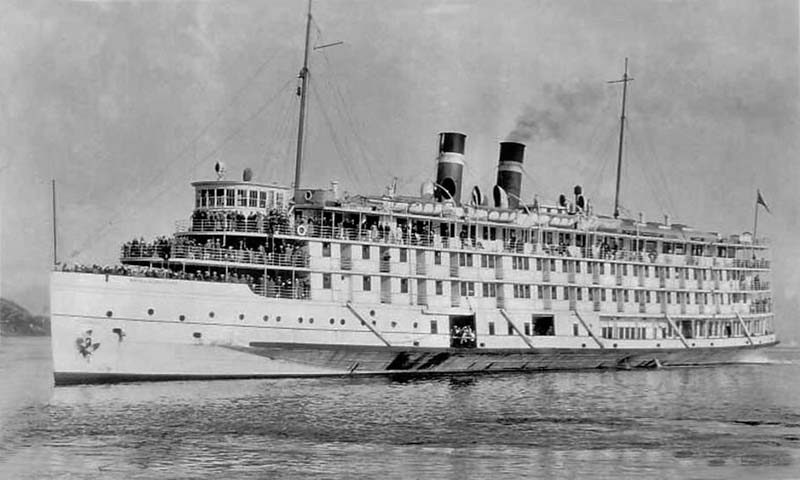
The financial backing of Furness, Withy & Co. Ltd. in 1911 of the Richelieu and Ontario Navigation Company allowed Montreal financier W. Grant Morden (born in 1880), and grain merchant James Carruthers (1853-1924), and shipowner James Playfair (1860-1937) to take over ten Great Lakes fleets, including:-
- Thousand Islands Steamboat Company
- St. Lawrence River Steamboat Company
- Niagara Navigation Company with services on Lake Ontario
- Northern Navigation Company with services on Lake Huron and Lake Superior
- Inland Navigation Company with cargo services
- The American subsidiary of the Richelieu and Ontario Navigation Company
- Four more small Great Lakes steam boat companies
These merged fleets formed the Canada Transportation Lines Ltd. on 17th June 1913, which by a process of absorption had been renamed as Canada Steamship Lines (CSL) by the end of 1913. CSL had a big nominal capital of $34.5 million in shares, debentures and mortgages with James Carruthers as its first President, and James Norcross as its first Managing Director.
CSL Passenger Fleet
Saguenay River
The beautiful, fjord like Saguenay River drains Lac Saint Jean in the Lawrentian Highlands, and has the twin peaks of Cape Eternity and Cape Trinity rising to 1,800 feet on the western side. Today, the river is part of the St. Lawrence Marine Park. Tadoussac lies at the entrance to the Saguenay river at its junction with the St. Lawrence, and was the first permanent French settlement in North America, and very important in their fur trapping trades. When CSL took over the Richelieu and Ontario Navigation Company, a variety of small passenger craft were used during the first ten years including Tadoussac (1879), Cape Diamond (1877), Cape St. Francis (1867), Cape Trinity (1911), Cape Eternity (1910) and Saguenay of 2,777 grt. The latter had been built by the Fairfield yard at Govan in 1911 for the Richelieu and Ontario Navigation Company and was a handsome white hulled passenger steamer on the Saguenay until 1931, and then ran as cargo only until laid up and later sold in 1946.
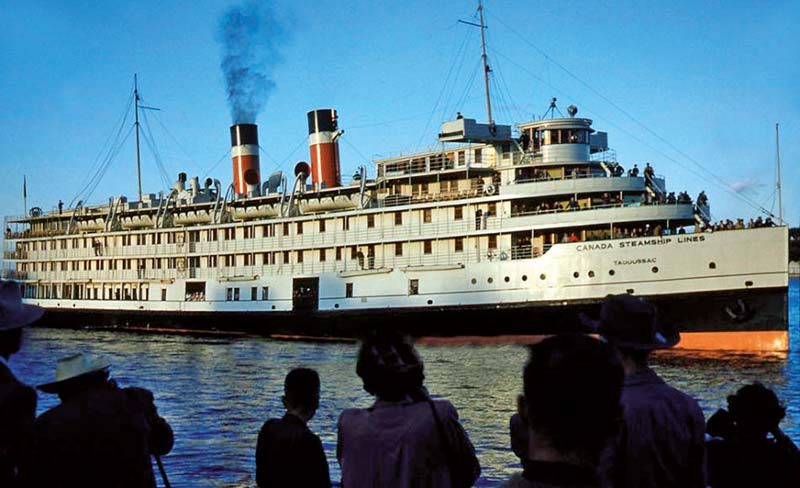
The twin funnelled Richelieu of 3,539 grt was used on the Saguenay by CSL from 1923 until the end of their last season of 1965. She had an interesting history when completed at Wilmington (Delaware) in 1913 as Narrangansett with her exact sister Manhattan. They were ordered by Charles M. Hayes, President of the Grand Trunk Railroad for a proposed service from Montreal to New York. Unfortunately, Hayes drowned in the Titanic disaster, and Narrangansett was laid up until she steamed to Europe for troopship service in 1917. She was purchased by CSL in 1919 and reconditioned at a cost of $1.2 million and entered Saguenay river service in the Spring of 1923. She closed out the Saguenay river service at the end of the 1965 season and was towed to Belgium for breaking up.
A trio of new twin funnelled passenger ‘hurricane deckers’ entered CSL service in 1927/28 from Davie Shipuilders as St. Lawrence of 6,328 grt, Tadoussac of 7,013 grt and Quebec of 7,016 grt. They were intended primarily for the overnight Montreal to Quebec service but also operated in summer on the Saguenay. They cost $1.2 million each and had four passenger decks with sixteen double banked lifeboats on the hurricane deck and accommodation for 1,200 passengers. Quebec was destroyed by fire in August 1950 on a Montreal to Saguenay voyage with the loss of the lives of seven passengers. St. Lawrence sailed on to close the service at the end of the 1965 season, and she was then towed to Belgium for scrapping. Tadoussac also closed out the service at the end of the 1965 season, but found a buyer for further service in the United Arab Emirates as a hotel. In earlier times, up to 1927, an overnight service only between the two cities of Montreal and Quebec was operated by the twin funnelled CSL steamers Montreal 4,282grt/1902 and Quebec 3,498grt/1865.
Niagara To The Sea
A leisurely four day tourist voyage could be taken on CSL steamers from Niagara Falls to the sea at the Saguenay river. Suitably dressed in waterproofs on the first morning, a small boat took one right into the mist and spray at the bottom of the impressive Niagara Falls, thousands of tons of water cascading every hour over the lip from water descending from the higher Lake Erie into the Niagara River and Lake Ontario. The small boat would then return to a dock on the Niagara river or to Niagara on the Lake to allow one to take an afternoon voyage of two and one half hours to Toronto on the Canadian side of Lake Ontario. One of the CSL steamers Chicora 931grt/1864, Corona 1,274grt/1896, Chippewa 1,514grt/1893 or Cayuga 2,196grt/1907 transported one to a Toronto hotel for the overnight stay. An early start on the second day was necessary for the nine and one half hour voyage to Prescott through the very beautiful One Thousand Islands, using the CSL steamers Kingston 2,925grt/1901 or Toronto 2,779grt/1899. An overnight stay at Prescott would be followed by a dramatic third day voyage down the white water rapids from Prescott to Montreal. This was probably the most thrilling descent of rapids anywhere in the world, ‘shooting the rapids’ in water only six feet deep at best, in three CSL steamers with wood sheathed keels to prevent damage to their hulls. A special pilot was required for two stretches of dangerous white water rapids, at Long Sault rapids and the Lachine rapids, on the Rapids King 1,563grt/1907, Rapids Prince 1,314grt/1910 or Rapids Queen 770grt/1892. The best view of the rapids was obtained from the bow of these small steamers, which would return from Montreal to Prescott after the passengers had disembarked by canal at the side of the St. Lawrence overnight. The fourth day of the voyage was the most scenic, taking one of the several Saguenay river CSL ‘hurricane deckers’ described above from Montreal for a spectacular end to a short holiday.
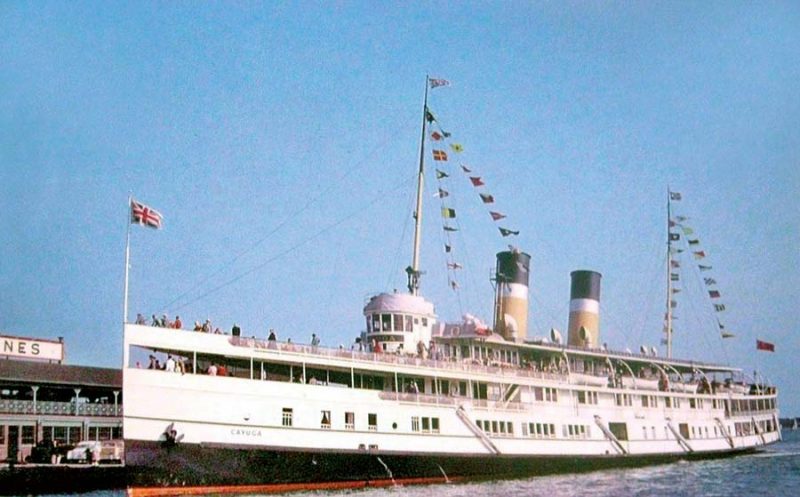
Northern Route To Lake Huron And Lake Superior.
This was the western Great Lakes route from Detroit at the foot of Lake Huron, or Sarnia on the Canadian side, through the Sault Sainte Marie (Soo) locks into the scenic Lake Superior and the picturesque St. Mary’s river and Thunder Bay near Port Arthur to the terminal at Duluth at the western end of Lake Superior. This, in effect, was a connecting service to the great Continental rail lines taking the route across Canada to British Columbia and was well patronised by both passengers and cargo. The last wooden passenger ship built at Collingwood (Ontario) was Germanic 1,014grt/1899, and she operated for CSL on the route from 1913 to 1917 until destroyed by fire in winter lay up. Three black hulled steamers then took over the Northern route in Hamonic 5,265grt/1909, Huronic 3,330grt/1902 and Noronic 6,905grt/1913. Huronic operated between 1914 and 1934 with passengers, and then in cargo only mode until sent for breaking up in 1950. Hamonic was destroyed by fire in July 1945 at Point Edward (Ontario), but fortunately all crew and passengers were saved. Noronic was destroyed by fire at Toronto in September 1949 while on a post season cruise, unfortunately with the loss of 118 passengers, most while asleep in their bunks. The burnt out hulk was fit only for breaking up, and the Northern service itself closed down soon afterwards.
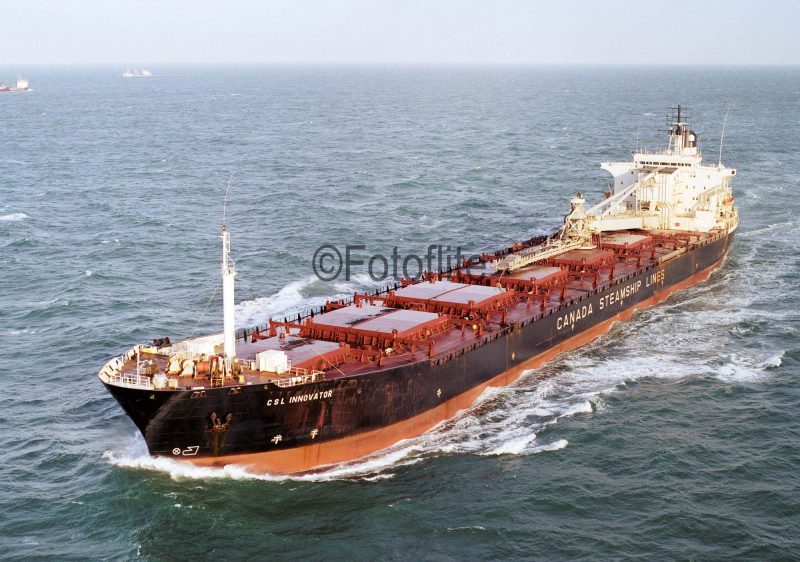
CSL Freight Fleet
The size of the bulk freight fleet was constrained by the size of the old lock systems on the Great Lakes before the opening of the Welland Canal in June 1931. A fleet of thirty ‘Canallers’ was inherited from the cargo fleet of the Inland Navigation Company in 1913, and many were requisitioned for service on the other side of the Atlantic during the Great War. Midland Queen was shelled and sunk by U68 on 4th August 1915 while on her crossing voyage from Sydney (NS) to Newport in Monmouthshire when only sixty miles from the Fastnet Rock, fortunately her crew was saved. Thirteen more CSL freight vessels succumbed to torpedoes, mines and shells including Acadian, Armonia, C.A. Jacques, D.A. Gordon, Doric, Dundee, Empress of Fort William (ex Mount Stephen), Empress of Midland, Glenmount, Neepawah, Scottish Hero, Strathcona and Tagona. Donnacona and Dunelm were also lost to marine causes while requisitioned around the British shores.
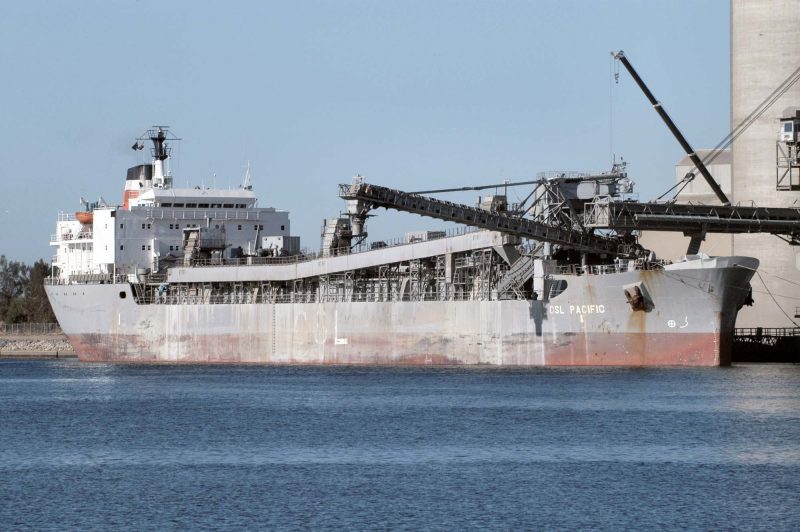
A big combined fleet of seventy freight and passenger steamers was being operated in 1919, including the war survivors Bermudian, A.E. Ames, A.E. McKinstry, Fordonian, H.M. Pellatt, Hamiltonian, J.H. Plummer, Kenora, Mapleton, Renvoyle, Rosedale and Winona. Bermudian was a passenger liner of 5,530 grt built on the Wear for the Quebec Steamship Co. Ltd. in 1904. She maintained a service between New York to Bermuda and the Caribbean with her owning company becoming a subsidiary of CSL in 1913. She was sold off in 1919 to Furness, Withy & Co. Ltd., which had much bigger plans to increase the service with large passenger liners. In 1918, the first ship was acquired for a North Atlantic service and a large schooner was purchased for the Trans Pacific lumber trade. A fleet of eight more deep-sea ships was also acquired shortly afterwards for $8 million for a short lived joint North Atlantic service with French Line. Ships were then chartered from Norwegian shipowners, such as Brant County 5,289grt/1915 of Bergen Line, for the County Line service across the North Atlantic, which ran for the next forty years.
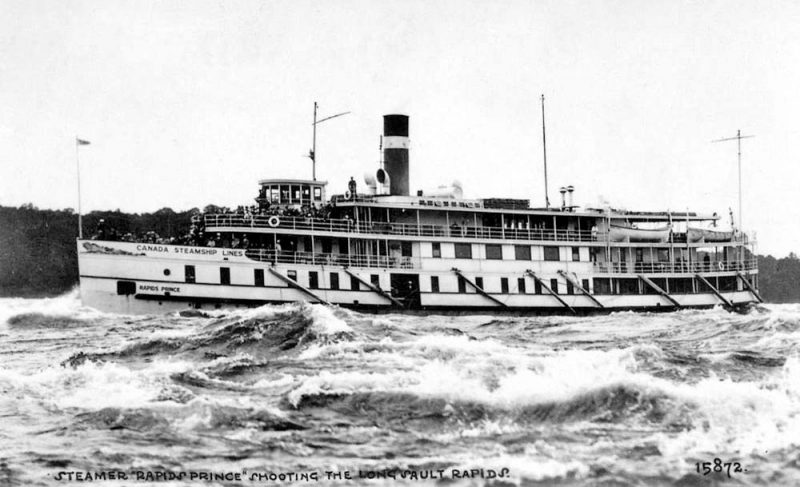
The first new self unloader ‘Canaller’ was completed in 1924 as Collier of 1,858 grt from the Vickers yard at Barrow. CSL took over the shipyard of Collingwood Shipbuilders, building red hulled ‘Canallers’ with engines aft and navigating bridge over the bows such as Barrie 1,824grt/1925, and also the shipyard of Davie Shipbuilders of Lauzon (Quebec), which built similar bulkers such as Selkirk 2,384grt/1926. Donnacona of 8,600 grt was the new name in 1926 of the former W. Grant Morden, built in 1914 by the Western Dry Dock and Shipbuilding Company of Port Arthur as the biggest Laker of its time. She served CSL for 55 years until she steamed down the St. Lawrence Seaway in July 1969 and was then towed to Bilbao for breaking up.

The bigger Upper Great Lakes bulkers could not of course proceed out of the Lakes due to the lock sizes around the rapids between Thousand Islands and Montreal, and were used only on the Upper Lakes bulk routes. Lemoyne 10,480grt/1926 and 18,000 dwt on dimensions of length 621.0 feet and beam of 70.2 feet was completed by the Midland Shipbuilding Co. Ltd. at Midland (Ontario) on Lake Huron, and was the biggest CSL bulker for the next two decades. She had thirty five hatches to load her cargo into a single long hold, and was powered by a triple expansion steam engine supplied by Hoovens, Owens & Rentschler of Hamilton (Ontario). Gleneagles 8,293grt/1925 came from the same yard and engine builder as Lemoyne, and a dozen of the smaller ships known as ‘Canallers’ were built by Swan, Hunter & Wigham Richardson Ltd. and other yards on the Tyne, with Coalhaven 2,362grt/1928 from the Furness yard on the Tees and having a trunk deck of length 145 feet.
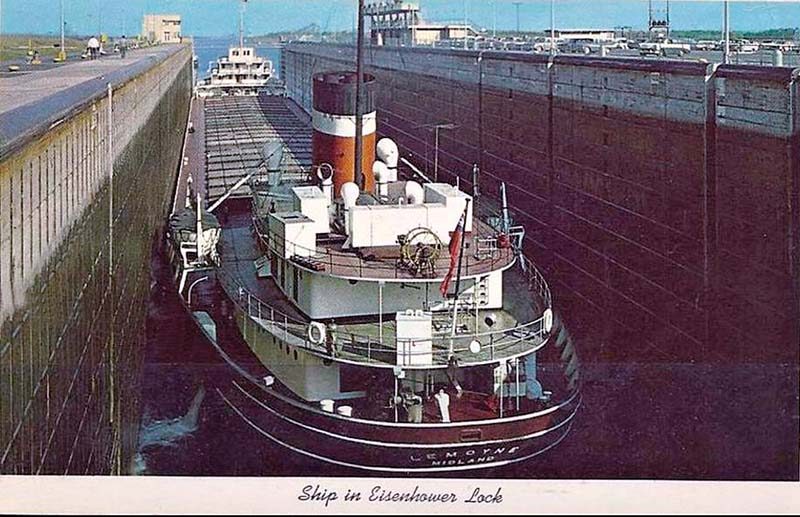
The Tyne built ‘Canallers’ included:-
- Beaverton 2,012grt/1905
- Canadian 2,214grt/1907
- Glenross 3,219grt/1925
- Glenledi 3,571grt/1925
- Glencassie 1,901grt/1928
- Glencorrie 1,783grt/1923
- Glengeldie 1,908grt/1923
- Glenlockie 1,904grt/1923
- Glenlinnie 1,910grt/1923
- Glenbuckie 1,901grt/1923
- Glenorvie 1,893grt/1923
- Glenburnie 1,905grt/1923
- Mapleheath 1,692grt/1910
This fleet of steamers with ‘Glen’ prefixes to their names was owned by the Glen Line of Midland (Ontario) with James Playfair of Collingwood (Ontario) as owner, who had a sizeable shareholding in CSL, with his fleet and Collingwood shipyard then purchased for $12 million by CSL in 1926, losing their ‘Glen’ names to be renamed with Canadian names.
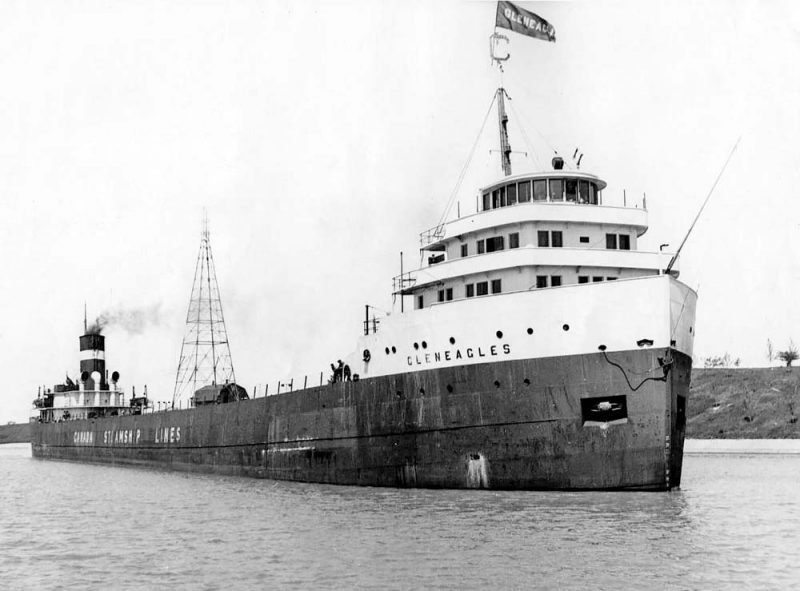
Mapleheath was an interesting ship in that Swan, Hunter & Wigham Richardson Ltd. had built her as the first British funnelless seagoing motorship Toiler with Swedish diesels powering her twin propellers. She was renamed Mapleheath by CSL in 1920 and then converted into a steamer in 1929 with triple expansion steam engines. Glenledi and Glenross were longer than the maximum size of ‘Canaller’ to transit the Welland Canal and thus served on the Upper Lakes, but to get there they were completed on the Tyne at the maximum length permitted for transit, with steel for ‘midships sections shipped out in their holds to undergo ship surgery into larger vessels at the Collingwood Shipyard at Collingwood (Ontario) on Lake Huron.
The CSL fleet on the outbreak of World War II comprised a dozen passenger steamers and seventy five Great Lakes engines aft ‘Canallers’ and bulkers, down slightly from the peak size of 105 steamers in 1933. The ‘hurricane decker’ passenger ships had accommodation for 1,200 passengers on several full length passenger decks, and were equipped with bow rudders for easier navigation in narrow waters. The biggest bulk Lakers could carry half a million bushels of wheat in a single Upper Lakes voyage, but could not make the voyage down to the lower St. Lawrence and help the Allied war effort due to size restrictions on the Welland Canal. The small Lakers of up to 3,000 dwt, known as ‘Canallers’, could pass through the Welland Canal, and several CSL ‘Canallers’ were requisitioned to cross the Atlantic to serve on East Coast coal convoys during the war. A.E. McKinstry, Lennox, Magog, Mapleton, Norfolk, Winona, Waterloo and others crossed the Atlantic, with Magog, Waterloo, Lennox and Norfolk lost to enemy action between 1940 and 1942. A.E. McKinstry, Mapleton and Winona survived both world wars while requisitioned to Britain, with Winona having the honour of carrying supplies to Normandy one day after the D Day landings.
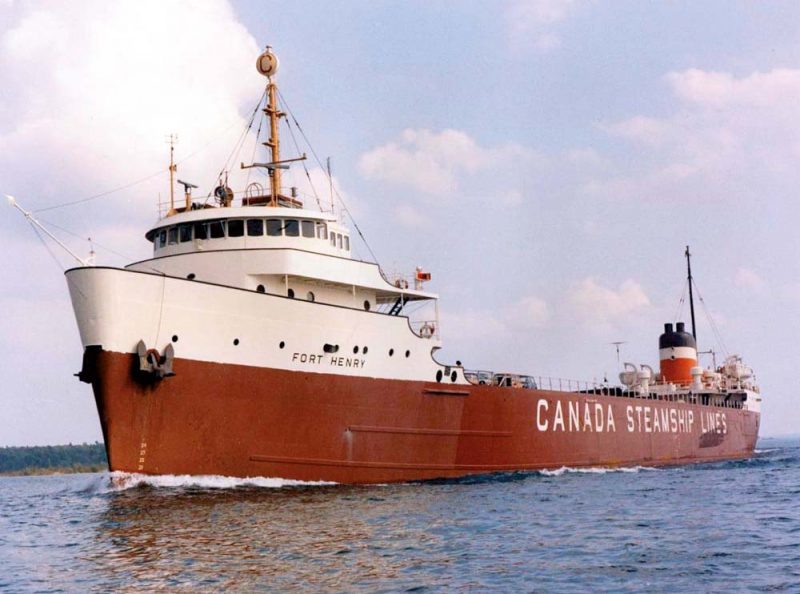
The big self unloaders in the CSL fleet had unloading booms of two hundred feet in length, with discharge rates of between 8,000 to 10,000 tons in five hours. Their regular cargoes of iron ore (94 million tons per year in the war years) and coal (50 million tons per year in the war years) were vast in size, and were very important to the Allied effort but were usually overlooked in Europe. This huge size of cargo was twice the cargo tonnage passing through the Panama Canal during the war years.
The CSL fleet in 1950 numbered a total of 55 passenger and freight ships with new big self unloaders completed in 1949/1950 as Hochelaga and Coverdale of 12,000 grt and 18,000 dwt, and thus eclipsed the biggest pre-war survivor Lemoyne 10,480grt/1926 for the first time. Coverdale was named in memory of W. H. Coverdale, CSL President for 27 years until his death in 1949. He had been born at Kingston on Lake Ontario and was a great proponent of the CSL passenger steamers on their Great Lakes routes and especially the cruises to the lower St. Lawrence and up the beautiful Saguenay river, with the CSL Manoir Richelieu Hotel for travellers to stay at and admire the scenery and the twin peaks of Cape Eternity and Cape Trinity.
In 1960, there were only three CSL ‘hurricane decker’ passenger steamers left in Tadoussac, Richelieu and St. Lawrence. There was, however, a big fleet of sixty freight Lakers and Canallers, with the latest big Lakers being the new Murray Bay and Whitefish Bay of 17,350 grt and 25,000 dwt completed in 1960. The other big CSL Lakers were:
- Lemoyne 10,480grt/1926,
- Hochelaga 12,000grt/1949,
- Coverdale 12,000grt/1950,
- Georgian Bay 11,392grt/1954,
T.R. McLagan 15,500grt/1954, and the sisters Thunder Bay 12,433grt/1952 and Sir James Dunn 12,433grt/1952 of 19,711 dwt, the latter named after the owner of Algoma Steel, who had gained control of CSL in 1951 but had died in 1956. The red hulled bulker named after him had been completed by the Port Arthur Shipbuilding Company (Ontario) on dimensions of length 647 feet, beam of 62 feet and depth of thirty feet, and served for 37 years until broken up in Turkey in 1989.

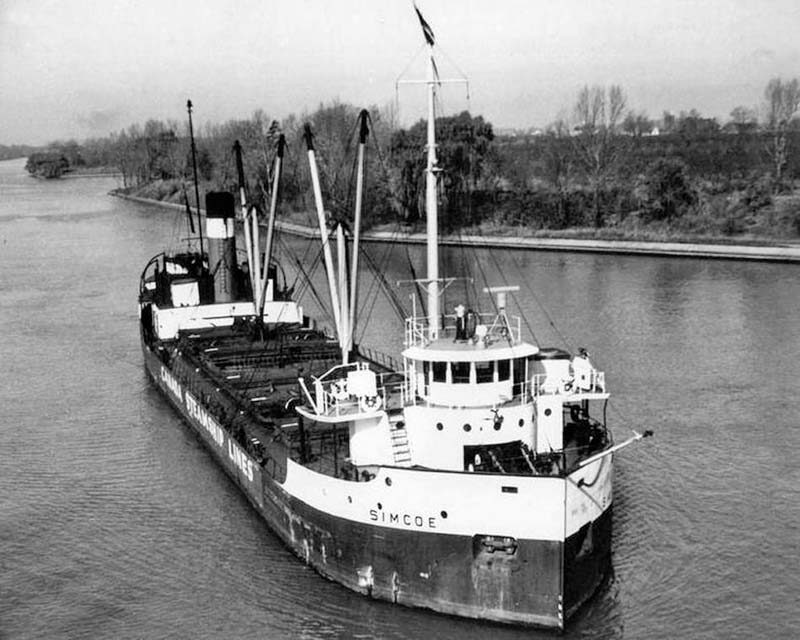
There were also five CSL pallet carriers of 6,000 grt named Fort Chambly, Fort Henry, Fort St. Louis, Fort York, and Fort William, as well as two pallet carriers managed for the Canadian General Electric Co. Ltd. in English River 6,640grt/1960 and French River 6,640grt/1960, and one managed for the Steel Company of Canada in Hamiltonian 5,852grt/1960. Some of these pallet carriers were later converted into cement carriers.
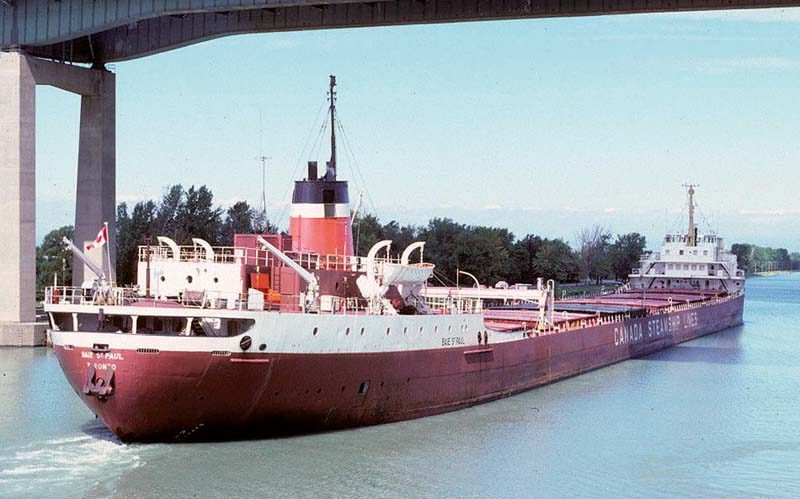
Metis of 3,870 dwt was the newest ‘Canaller’ and also the last in the CSL fleet when completed in 1956 by the Davie Shipbuilding yard at Lauzon on dimensions of length 253.0 feet, moulded beam of 43.9 feet, moulded depth of 22.6 feet and loaded draft of 17.6 feet. She operated between the Great Lakes and the St. Lawrence river in the coal, ore, grain and pulpwood trades, and was a twin screw motorship powered by twin Fairbanks Morse four cylinders diesels of 1,280 bhp to give a service speed of eleven knots. Metis was lengthened in 1959 at Kingston, and then converted in 1965/1966 to a bulk cement carrier, also at Kingston, with unloading equipment fitted from the old steamer Glenelg. Metis is still very much operational in the Great Lakes today after a career of sixty years.
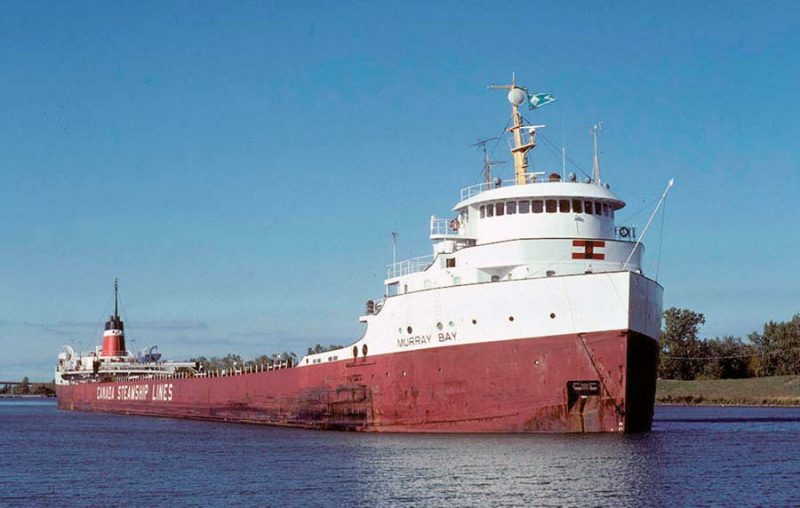
T. R. McLagan was President of the company in 1960, with six Vice Presidents controlling General Freight Traffic, Coal and Ore Traffic, Grain Traffic, Pallet Traffic, Operations, and Ship Construction, together with 17 directors and the company secretary. The CSL shares had been sold off after the death of Sir James Dunn in 1956, and in 1963 Paul Desmarais acquired a majority holding and took effective control of the company a few years later. However, the big event on the Great Lakes at this time was the opening of the St. Lawrence Seaway in April 1959 and which is now described.
St. Lawrence Seaway
The St. Lawrence Seaway was opened on 25th April 1959 after five years of construction with seven locks on the St. Lawrence river portion of the Seaway, and eight locks in the enlarged Welland Canal portion of the Seaway. The CSL vessel Simcoe of 1,783 grt was the first vessel to pass through the new Seaway on this day. H. M. Queen Elizabeth II and U.S. President Dwight Eisenhower formally inaugurated the Seaway on 26th June 1959. The Seaway is thus a system of locks, canals and channels in Canada and the United States that permit deep sea vessels to voyage from the Atlantic Ocean to the Great Lakes as far inland as the western part of Lake Superior. The Seaway thus bypasses several sections of rapids and shallows to give a major trading highway that stretches from Montreal to Lake Erie and thus give access to deep sea ships some 2,340 miles from the North Atlantic into the heartland of Canada and the United States. The major export of the Great Lakes is grain, but coal, iron ore and other bulk cargoes figure prominently to and from the industrial belt of Chicago, Milwaukee and Detroit. The navigation season is limited by ice from April to early December, but during that period the two biggest grain exporters in the world, Canada and the United States, export wheat and corn from two main grain belts running through the U.S. Midwest and the Canadian Prairies. Coal is exported from the Appalachian coalfields in the U.S.A., and from the Canadian coalfields in the mid-west. Iron ore is carried through the St. Lawrence Seaway from the Labrador ore fields to the U.S. steel producers.
The heart of the St. Lawrence Seaway is the system of fifteen locks, seven on the St. Lawrence portion starting at Montreal and working upstream:-
- St. Lambert Lock at Saint Lambert (Montreal) – ships lifted 15 feet
- Cote Sainte Catherine Lock at Sainte Catherine (Quebec State) – ships lifted 30 feet
- Beauharnois Locks (two locks) at Melocheville (Quebec State) – ships lifted 82 feet
- Snell Lock at Massena (New York State) – ships lifted 45 feet
- Eisenhower Lock at Massena (New York State) – ships lifted 38 feet
- Iroquois Lock at Iroquois (Ontario) – ships not lifted
Together with eight locks on the Welland Canal portion of the Seaway to give access between Lake Ontario and Lake Erie, lifting ships a total of 326 feet:-
- Four locks at St. Catharines (Ontario)
- Three locks at Thorold (Ontario)
- One lock at Port Colborne (Ontario) to give the final access into Lake Erie if going upstream and the first access into the Welland Canal if going downstream.
The locks are 766 feet long, eighty feet wide, and thirty feet deep, with the maximum permitted size of vessel being 740 feet in length, 78 feet in beam, and 26.5 feet deep. The vessels that are built and use the system today are of the latter size and known as SeawayMax. Larger vessels that today operate on the Upper Lakes are constrained only by the 1,200 feet long, 110 feet wide and 32 feet deep locks at Sault Sainte Marie to give access into Lake Superior. There are at least one dozen big Lakers today of length over 1,000 feet and beam of over 105 feet that operate only in the Upper Lakes and cannot reach the North Atlantic through the St. Lawrence Seaway.
The St. Lawrence River channel depths in the Seaway are 41 feet (or Panamax depth) downstream from Quebec City, and 35 feet between Quebec City and Descahaillons, and 37 feet from there to the start of the Seaway at Montreal. Thus all Panamax, Kamsarmax and Capesize vessels cannot use the Seaway today, and can only arrive part loaded at Montreal. Cargoes for these bigger vessels are usually transhipped at Lower St. Lawrence ports such as Baie Comeau from Lakers coming out of the St. Lawrence Seaway. There are plans to increase the size of vessels allowed to use the Seaway, but the costs are staggering as vessels are lifted a total of 570 feet through the fifteen locks. The cost of the 1959 St. Lawrence Seaway was 470 million Canadian dollars, of which 336.2 million Canadian dollars was paid by the Canadian Government, and the remainder by the U.S. Government. The project used 22,000 workers at one time or another, and today generates several billions of dollars of revenue for both the Canadian and U.S. Governments.
The St. Lawrence Seaway today handles 50 million tonnes of cargo per year, with half of this total being international from European, Middle Eastern and African ports, and the other half between Canadian and American ports. The Seaway tolls are reasonable and based on the number of locks transitted, with all foreign trade vessels required to have a pilot onboard. Thus, the St. Lawrence Seaway is a vast improvement over the first small Canal de Lachine that was built at Montreal in the 1820s.
‘Salties’ and Lakers
During the seven years from 1959 to 1966 after the St. Lawrence Seaway had opened, CSL experienced a double increase in cargoes carried, with large movements of iron ore from the newly exploited Labrador ore fields at Labrador City, Schefferville, and Mont Wright. The railways moved huge amounts of iron ore to Sept Iles and Port Cartier, from where CSL Lakers moved the iron ore to the Great Lakes smelters, and CSL Lakers also moved coal, grain and other bulk cargoes downstream for transhipment into Capesize bulkers at anchor in the lower St. Lawrence. Draught restrictions meant that giant Capesizes could only take on a part cargo, and these ships were also loaded in the Strait of Canso or off American ports by up to four CSL self unloaders, two to port and two to starboard.
In 1969, the Power Corporation of Montreal took a majority holding in CSL, with Paul Martin, an Executive of Power Corporation, appointed to the Board of CSL a year later. In 1971, the majority holding increased by the purchase of almost all of the shares of minority shareholders, making CSL a subsidiary of Power Corporation. CSL suffered financial losses in 1972 from having to foot the bill from cost overruns of three Aframax tankers building at their subsidiary yard of Davie Shipbuilding. Paul Martin was appointed President and CEO of CSL in November 1973, replacing Paul Desmarais, and he soon announced plans to expand the CSL fleet of ‘salties’ to trade outside of the Great Lakes and the St. Lawrence Seaway.
In 1975, the CSL fleet size stood at thirty vessels with ten new gearless Lakers in Baie St. Paul, Nipigon Bay, Georgian Bay, Murray Bay, Black Bay, Quetico, Richelieu, Rimouski, Simcoe and T. R. McLagan. The many self unloaders including Tarantau of 1965, Manitoulin of 1966, Tadoussac of 1969, J. W. McGiffin of 1972, Frontenac and Saguenay converted in 1973, H. M. Griffith of 1974, Louis R. Desmarais and Jean Parisien of 1977, and Nanticoke of 1980. Two twin funnelled self unloaders of 38,500 dwt were then ordered in 1980, and were designed as both ‘salties’ on permanent worldwide deep sea trades or on Great Lakes trading. Atlantic Superior was built in two halves, the stern portion was launched by the Collingwood yard on 9th November 1981 and joined to the bow section from Port Arthur Shipbuilding on 11th June 1982. She moved into the Eastern Seaboard trades in 1984, and was joined that year by her sister Hon. Paul Martin, named after the Chief Executive, and renamed as Atlantic Erie for deep sea trading in 1988. A third sister was purchased in 1989 and converted to a self unloader and was renamed Atlantic Huron.
Two Panamax bulkers entered the CSL fleet in 1988/1990 as the self unloader CSL Innovator, converted at the Verolme yard of Angra dos Reis in Brazil and completed at Govan in 1982 as Pacific Peace for C.Y. Tung of Hong Kong, and the new Panamax self unloader CSL Atlas from the same Brazilian yard in 1990. This pair and the trio of 38,500 dwt self unloaders were used and continued to be used with later self unloaders on the following ‘saltie’ trades for clients such as National Gypsum, PortLine of Lisbon, Construction Aggregates and Vulica Stone:-
- Gypsum from the Great Lakes and Halifax (NS) to Wilmington (NC) and Tampa
- Coal from the Tyne, Immingham or Norfolk (Va) to Sines (Portugal) and El Ferrol (Spain)
- Iron ore from Brazil or Almeria to U.K. ports and the Great Lakes
- Nickel ore from Puerto Bolivar (Colombia) to Sweden
- Salt from St. John (NB) to Boston Urea from Vancouver to California
- Potash from the Great Lakes to Baltimore
- Phosphates from Tunis to Hamburg
- Crushed granite from Nova Scotia to St. Lucia and St. Vincent
- Granite chips from Glensanda to Isle of Grain during Channel Tunnel construction
- Stone chips from Labrador to Stavanger for ballast in gravity weighted North Sea oil storage terminals
In 1990, the CSL fleet stood at 32 self unloaders and four Panamax bulkers, and there would have been four further self unloaders if a project had not fallen through to ship granite chips from Mexico to Canada. The quartet had been ordered from the Verolme yard in Brazil in a joint venture between CSL and Vulica Stone, and the shipyard then struggled to sell the ships on the open market. In January 1991, CSL joined with two Great Lakes competitors, Misener Holdings and James Richardson Shipping, in a new Great Lakes pool named Great Lakes Bulk Carriers.
CSL International INC.
CSL International Inc. was formed in April 1992 as a subsidiary in Beverley (Massachusetts) for deep sea trading, with CSL continuing to be headquartered in Montreal for Great Lakes trading under the conglomerate of CSL Group Inc. A joint self unloader pool was then formed in 1993 with the big self unloader fleet of Egon Oldendorff of Lubeck, with CSL Innovator sold to Oldendorff at this time and renamed Christoffer Oldendorff. The self unloaders Alice Oldendorff, Bernhard Oldendorff (ex Yeoman Burn), Caroline Oldendorff (ex Yeoman Brook), Johanna Oldendorff, E. Oldendorff, and Sophie Oldendorff later joined the CSL International pool, with Marbulk (a subsidiary of Algoma Central) also joining the pool in 1999 and Torvald Klaveness in 2002.
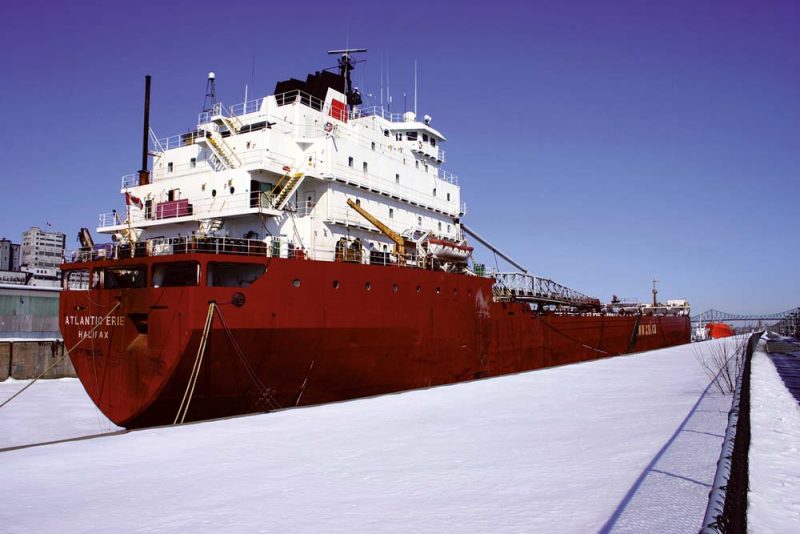
A pool of thirty self unloaders was then operated with Atlantic Superior, Atlantic Huron, Atlantic Erie, CSL Asia, CSL Atlas, CSL Cabo, CSL Spirit, CSL Trailblazer, CSL Metis (purchased in 2007 and the former Berge Helene), CSL Acadian (purchased in 2006), CSL Pacific, CSL Thevenard (purchased in 2008 and the former Polystar), CSL Yarra, Christoffer Oldendorff, Alice Oldendorff, Bernhard Oldendorff, Caroline Oldendorff, E. Oldendorff, Johanna Oldendorff, Sophie Oldendorff, Ambassador, Balder, Bahama Spirit, Ballangen, Barkald, Bauta, Eastern Power, Nelvana, Pioneer, Sheila Ann, Yeoman Brook and Weser Stahl, with two joining from ANL Bulk of Australia when taken over from the Australian Government by CSL in 1999. There have been several chartered ‘saltie’ bulkers including CSL Ride of 35,600 dwt.
The CSL Laker fleet was updated with new Lakers, purchased Lakers, and elderly Lakers fitted with new forebodies at Port Weller Dry Docks. Two such ship surgeries were completed and christened on the same day in April 2000 at Port Weller at the entrance to the Welland Canal. Three gearless Lakers were purchased in March 2002 from N. M. Paterson & Sons of Thunder Bay for the conventional grain, iron ore, coal, ilmenite, salt, coke, slag, limestone, dolomite, soyabean, canola, gypsum and petcoke trades. They were managed, as was now the practice with all CSL Lakers, by Acomarit Canada, a subsidiary of V Ships. Four Lakers were purchased from FedNav of Canada, with Chairman and owner Lawrence Pathy joint owner of CSL with CEO Paul Martin between 1981 and 1988. Paul Martin relinquished his day to day direction of the company in 1988 when he became a Member of Parliament. He was later elected Prime Minister of Canada on 12th December 2003, and had also sold all of his shares in CSL to his three sons to pursue the bid for leadership of the Liberal Party of Canada to prevent ‘any unnecessary distractions and obstructions’ from the other candidates.
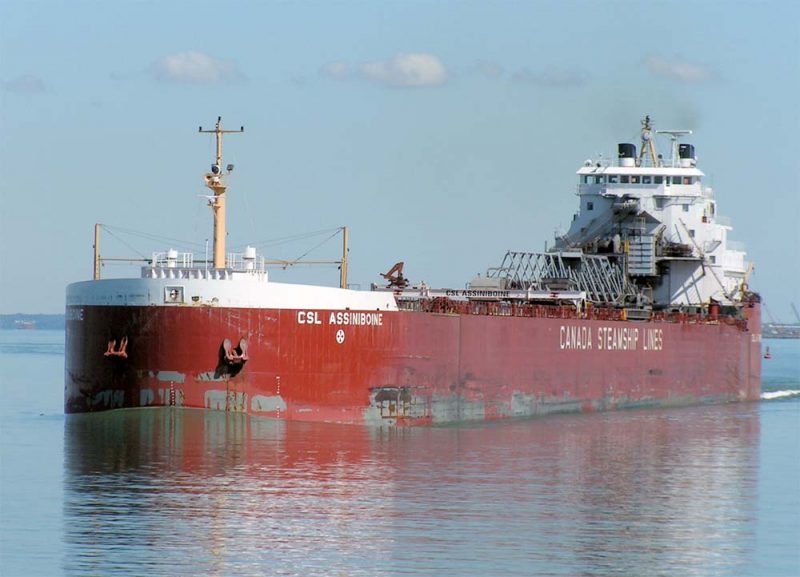
The gearless bulker Richelieu ran aground on 12th July 2010 after losing power near the Cote Sainte Catherine Lock and punctured a fuel tank spilling over 200 tonnes of diesel fuel, and resulting in the Seaway and the lock being shut down temporarily for the clean up, as well as a large fine for CSL. Richelieu was repaired and then sold off for further service. CSL International Inc. had by now been split into six regional areas for easier operation of CSL Americas (renamed from CSL International), CSL Australia (established 1999), CSL Asia (established 1994), CSL Europe (established 2010), CSL Transhipment (established 2010) and the CSL Laker fleet operating in the Great Lakes.
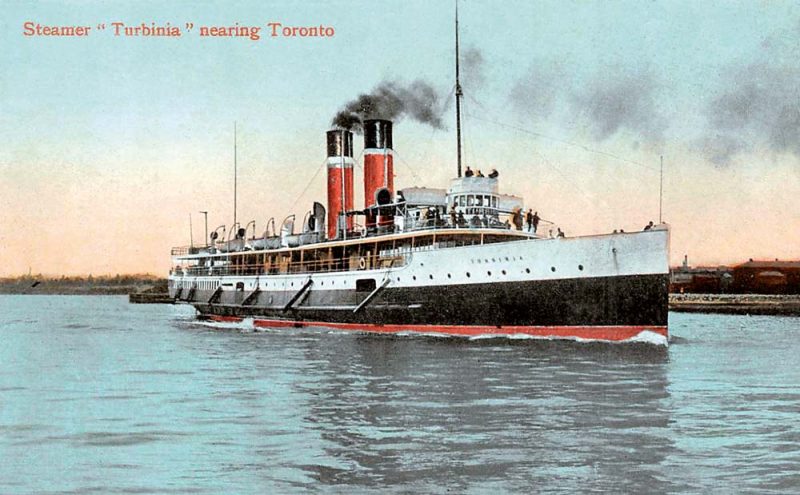
In August 2010, CSL ordered eleven ‘Trillium’ class vessels (four Laker self unloaders of 34,490 dwt, five Panamaxes self unloaders and two gearless bulkers of 36,630 dwt) in an order worth $514 million from the Chengxi yard in China. This was by far the biggest order in the long history of CSL, and a renewal of some of the elderly Laker fleet. A Laker costs on average around sixteen to eighteen million dollars more than a conventional bulker of the same size. The Laker ‘Trillium’ class vessels are Baie St. Paul, Baie Comeau, Whitefish Bay, Thunder Bay, while the Panamax ‘Trillium’ class vessels are Rt. Hon. Paul E. Martin, CSL Tecumseh, CSL Tacoma, CSL Tarantau (ex Balto), and Algoma Vision (ex Balchen). The latter quintet have dimensions of 228.0 metres length, moulded beam of 32.5 metres, moulded depth of 20.0 metres and summer draft of 13.5 metres with seven holds and seven hatches and discharging booms of length 80 metres. CSL Welland and CSL St. Laurent are the gearless bulkers of 36,630 dwt. Torvald Klaveness withdrew from the international pool in October 2015, with their five self unloader vessels sold to CSL and Algoma Central.
The CSL fleet currently is a big one of 66 vessels split into the six CSL Divisions:-
- CSL Great Lakes with 13 self unloaders and six gearless bulkers
- CSL Americas with 25 self unloaders
- CSL Australia with seven self unloaders and four transhipment vessels
- CSL Europe with five self unloaders
- CSL Asia with one transhipment vessel
CSL Transhipment with five transhipment vessels based in Singapore to manage global transhipment solutions from crane mounted vessels, barges and platforms. A new Transhipment Shuttle Vessel (TSV) can tranship cargo at 10,000 tonnes per hour in restricted rivers and severely restricted ports.
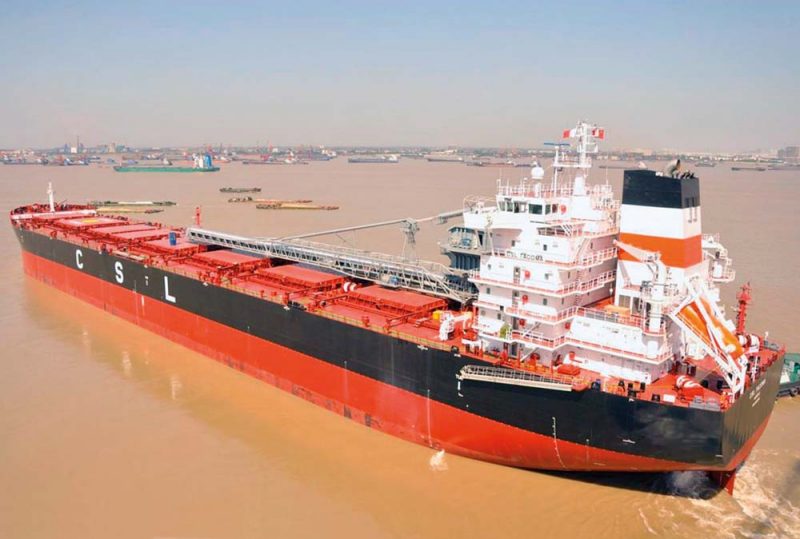
Postscript
The huge size of transhipment cargoes is illustrated by the shipment of 302,264 tonnes of iron ore at the end of December 2013 in Seven Islands Bay into the Chinese bulker CSB Years of China Shipping Bulk Carriers by several loads transhipped from CSL Spirit. This huge cargo was safely delivered to the smelters of the Wuhan Iron and Steel Company in China. Transhipment by CSL self unloaders also takes place off the Eastern Seaboard of Canada and the U.S.A., Australia, Indonesia, Africa and other regions to the tune of a total of over 30 million tonnes of cargo per year. The 38,500 tonne cargoes of coal that were shipped from the Tyne to Sines power station thirty years earlier in the first specially designed CSL ‘saltie’ self unloader, Atlantic Superior, seem small now in comparison. The company house magazine, CSL World, reflects the worldwide operations and nature of the company today.
One other CSL passenger steamer needs to be mentioned on her western Lake Ontario service between Toronto and Hamilton. This was the turbine powered Turbinia 1,064grt/1904 built by Hawthorn, Leslie & Co. Ltd. on the Tyne, and known on Tyneside as the ‘other’ Turbinia. The most famous vessel of that name was the 37.5 knot testbed of steam turbine inventor Sir Charles Parsons that sped through the Spithead Naval Review fleet on 26th June 1897 to herald the beginning of marine steam turbine propulsion. The Turbinia in question here was twin funnelled, powered by three steam turbines to give a trials speed of 22.5 knots, and became the first turbine powered ship in Great Lakes waters. She cost $175,000 and was operated by a succession of companies on her service, and spent the winters of 1904/1905 and 1905/1906 cruising between Kingston (Jamaica) and Santiago (Cuba) on charter to the Canada-Jamaica Steamship Company. She was acquired by CSL in 1913, and she then crossed the Atlantic for wartime service as a troopship and hospital ship, returning with a white hull to her old route until 1924/1925 when she was transferred to the main Montreal to Quebec service until laid up at Sorel (Quebec) in 1928. She was broken up there at the end of 1937.
The two shipyards owned by the CSL Group closed down thirty years ago, with Davie Shipbuilders Ltd. of Lauzon (Quebec) closed in 1982 with the last two CSL Lakers being Jean Parisienne (later CSL Assiniboine) of 1977 and Cedarglen of 1978. Collingwood Shipbuilders Ltd. of Collingwood (Ontario) closed down in 1986 after the completion of only one other vessel for other owners after the trio of CSL ‘salties’ Atlantic Superior, Atlantic Huron (as Prairie Harvest) and Atlantic Erie (as Hon. Paul Martin) in 1982/1985.
The centenary of the company was celebrated at Goderich in Ontario in November 2013 with an exhibition and careers stand, which also graphically told the story of the ‘Great Storm of 1913’ that raged across the Great Lakes for three days. This cost the lives of three hundred mariners, and resulted in twelve ships being lost including that of Regina belonging to CSL.

Seriously bad weather in the five Great Lakes of Superior, Michigan, Huron, Erie and Ontario still occurs today but is taken in their stride by the CSL fleet of today. We wish them well on their next one hundred years. Thanks are due to the excellent website at www.csl.com
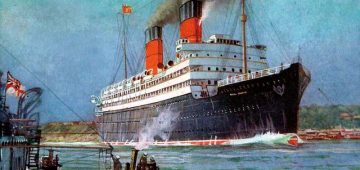
Comments
Sorry, comments are closed for this item